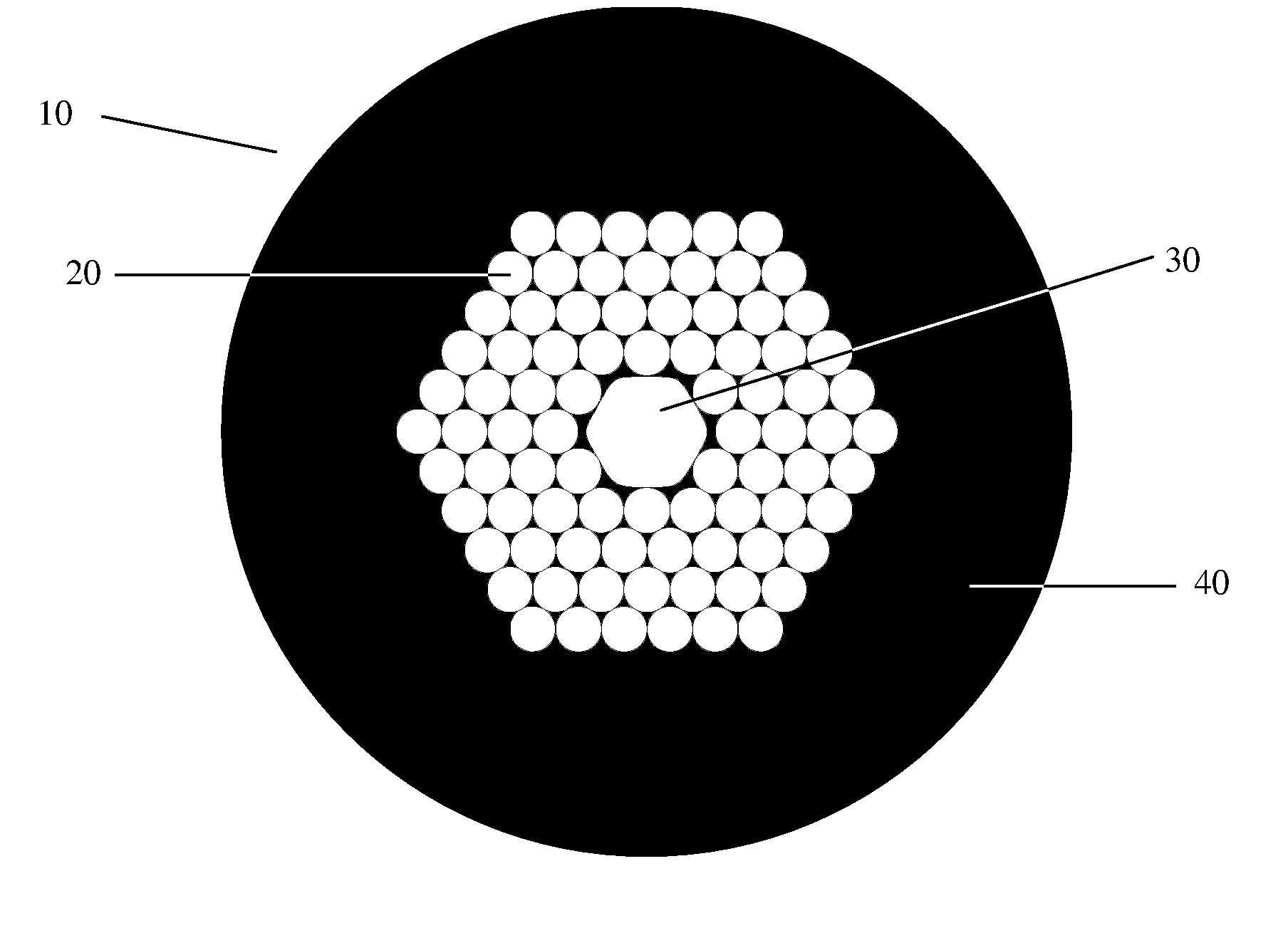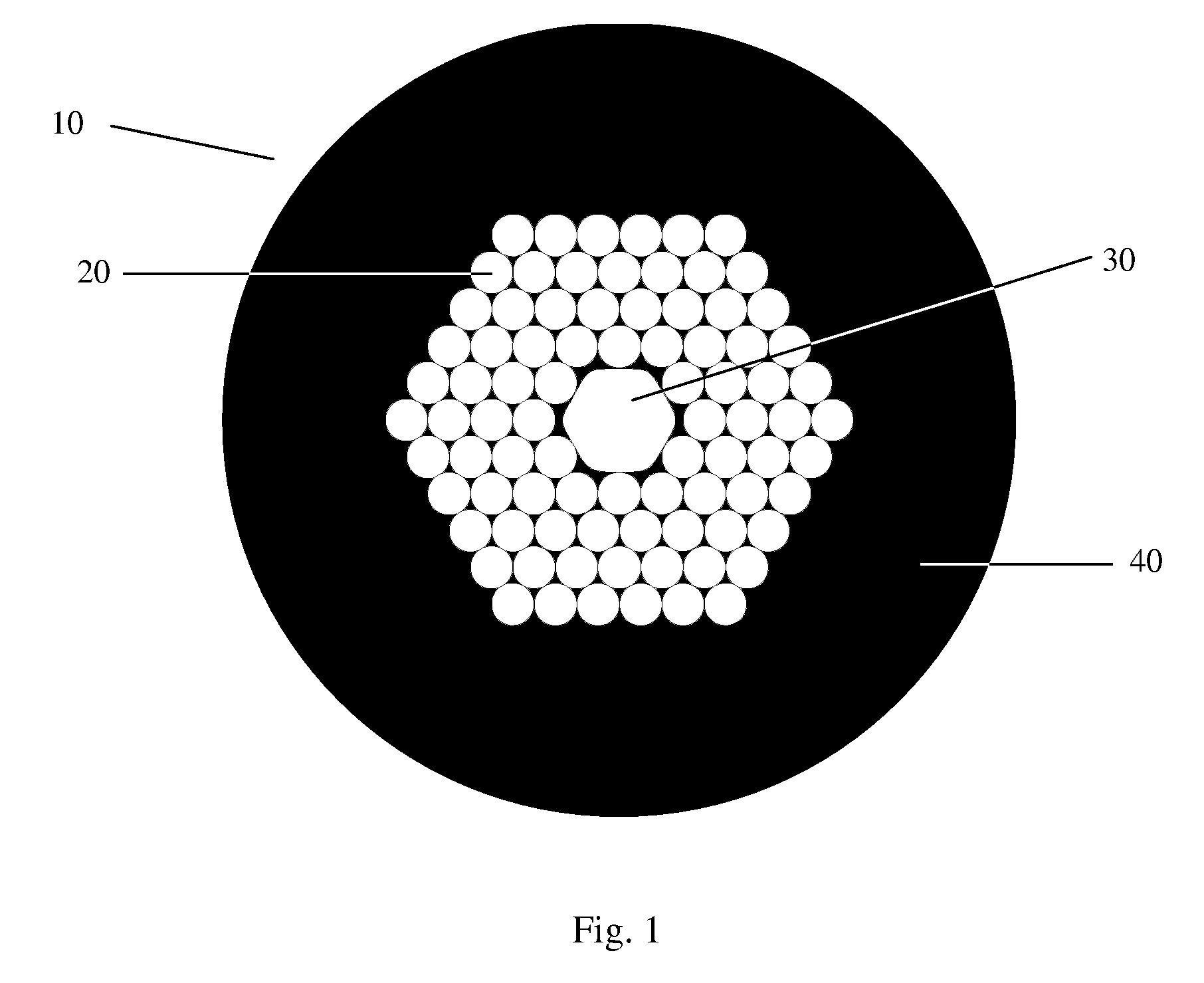High Air Fraction Photonic Band Gap Fibers
a technology of photonic band gap and high air fraction, which is applied in the field of high air fraction nonsilicabased glass fibers, can solve the problems of difficult manufacturing of high air fraction preforms, weaker specialty oxide and non-oxide glasses, and difficult handling,
- Summary
- Abstract
- Description
- Claims
- Application Information
AI Technical Summary
Benefits of technology
Problems solved by technology
Method used
Image
Examples
example 1
[0032] Single tube—A single glass tube made from As39S61 glass was drawn to a fiber under 2.8 in H2O gas pressure inside the tube. The ratio of the hole diameter to the outer diameter of the tube was increased considerably in the fiber by increasing the pressure in the hole during drawing. The air fraction was increased from 32% to 85% in this example. It can be even larger (>90%) depending upon the viscosity, temperature, draw rate, and pressure. The uniformity and concentricity was not compromised by this process.
example 2
[0033] Preform—This example pertains to a microstructured preform made from As39S61 glass having a large central opening and 12 surrounding openings in a single hexagonal configuration (3 openings per edge of the hexagon). The preform was placed on the fiber draw tower and attached to gas pressurizing assembly. The preform was heated up to 310° C when it softened and fiber drawing was initiated. The pressure above the microstructured preform was changed and this caused changes to the hole diameters. The central core was open to the atmosphere. Increasing the pressure increased the hole size and therefore air fraction in the fiber. For example, without gas pressure, the microholes in the fiber were about 6 μm in diameter. However, the application of a nitrogen gas pressure equivalent to 2 in H2O increased the micro-hole diameter to about 23 μm. The initial size of the microholes in the preform was about 1 mm diameter. This preform did not possess an optimized photonic band gap struct...
example 3
[0034] Increased gas pressure—This example shows how the air fraction of a microstructured preform, containing several layers of holes, can be increased by using gas pressure applied uniformly to the central opening and surrounding openings during fiber drawing. The glass was As39S6and the air fill fraction of the microstructured region of the preform was 74%. FIGS. 4(a)-(c) show pictures of microstructured fibers that were drawn using different pressures. FIG. 4(a) was generated with no gas pressure and resulted in an air fill fraction of 47%. FIG. 4(b) was generated with 1 in H2O of N2 in both the microstructured region and the central opening, and resulted in an air fill fraction of 58%. Pressure of 2 and 3 in H2O of N2 resulted in air fill fractions of 67% and 69% respectively. FIG. 4(c) was generated with 4 in H2O of N2 and resulted in an air fill fraction of 78%. It is clearly evident that increasing the pressure to 4 in H2O increased the air fraction as noted by the thinner w...
PUM
| Property | Measurement | Unit |
|---|---|---|
| diameter | aaaaa | aaaaa |
| wavelength region | aaaaa | aaaaa |
| viscosity | aaaaa | aaaaa |
Abstract
Description
Claims
Application Information
 Login to View More
Login to View More - R&D
- Intellectual Property
- Life Sciences
- Materials
- Tech Scout
- Unparalleled Data Quality
- Higher Quality Content
- 60% Fewer Hallucinations
Browse by: Latest US Patents, China's latest patents, Technical Efficacy Thesaurus, Application Domain, Technology Topic, Popular Technical Reports.
© 2025 PatSnap. All rights reserved.Legal|Privacy policy|Modern Slavery Act Transparency Statement|Sitemap|About US| Contact US: help@patsnap.com



